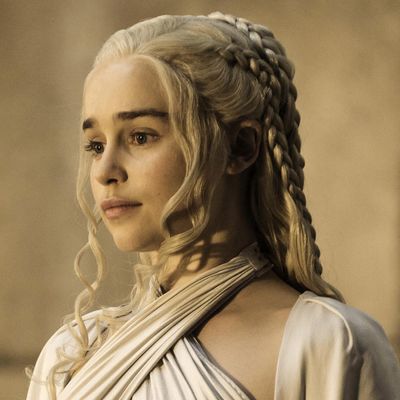
As in every HBO show that’s not Entourage, the characters on Game of Thrones are faced with hard decisions, but so far, no character on the show has had a harder decision than Daenery’s Targaryen’s Clash-inspired debate over whether or not to leave Meereen. On one hand, her people need her. On the other hand, she’s ruling an unfamiliar culture, her dragons keep eating small children, half the city hates her guts — and oh yeah, in last night’s season premiere, we learned that an insurgent group named the Sons of the Harpy is killing all her soldiers just for the heck of it.
But wait: Who exactly are the Sons of the Harpy?
Well, the first thing to know is that their title is metaphorical, not literal. (There’s a lot of them, so that would be one tired harpy.) The harpy is a traditional emblem in Ghiscari culture, and it figures prominently in the architecture of Slaver’s Bay; we’ve seen large harpy statues in Astapor, Yunkai, and, until the Unsullied pulled it down in last night’s episode, atop the Great Pyramid of Meereen. It’s like if the Empire State Building had a giant apple on top, if apples were a symbol of everything that was wrong with America.
The Sons of the Harpy gave themselves that name, then, because they see themselves as upholding the ancient traditions of Meereen, which in this case mostly means slavery. As in the antebellum South, slavery wasn’t only the primary economic engine of Meereen, it was also the central organizing factor of its citizens’ daily life. (Even if he can’t afford a slave, a poor man can take solace in the fact that at least he is not a slave himself.) These are people who literally live in a place called Slavers Bay — by outlawing slavery, Daenerys stripped the Meereenese masters of their identity. Is it any wonder they want revenge?
As the events of last season proved, Meereen’s elites couldn’t resist Danaerys’s invasion through conventional means. Not only were they outnumbered by the slaves within their walls, they also had to contend with an army of crack Unsullied, and three essentially unstoppable dragons. (Dragons are a touchy subject with the Ghiscari; thousands of years before the events of Game of Thrones, Old Ghis was the greatest empire in the world … until it was brought down by dragon-riding Valyrians.) But now that Daenerys has installed herself as a ruler, those advantages have dissipated. The dragons are indisposed, and the Unsullied are far less suited to their new roles as peacekeepers. Dany’s story line in Meereen is often talked about as an Iraq War metaphor, and it’s clear that George R.R. Martin drew upon the Iraqi insurgents while creating the Sons of the Harpy. Unable to defeat a superpower on the battlefield, they instead choose to make the occupation as painful as possible, striking quietly and without warning, then blending back into the local population.
Of course, with their terrifying golden masks (which they likely wear to hide their distinctive facial piercings), the Sons of the Harpy also bear a strong resemblance to the first wave of the Ku Klux Klan, which sprang up in the South in the years immediately following the Civil War. Though the the infamous white robes wouldn’t come until later, these early Klansmen adopted bizarre masks as cover for their terror attacks against freed slaves and white Republicans. Both the Sons and the Klan are essentially reactionary — the old order’s been overthrown, but they’re still violently enforcing its social hierarchy.
But while the early KKK was made up largely of independent local factions, the Sons of the Harpy so far appear to be operating as one cohesive force. In a way, that makes Dany’s job easier than her historical counterparts: A harpy’s not a hydra — cut off its head, and you don’t have to worry about a new one growing in its place.The Harpies likely have a leader, and leaders can be dealt with one way or another.


